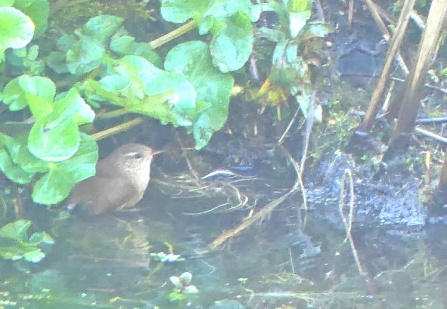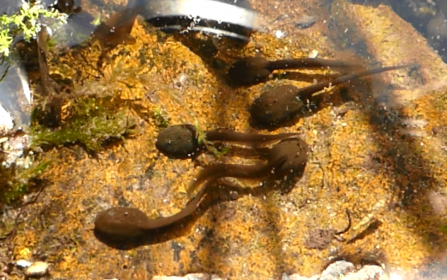I’m finding that watching birds in the garden from the upstairs window, binoculars and camera to hand, is more and more interesting. The more you look, the more you see. I’m also seeing our garden in context – wildlife doesn’t notice property boundaries! With reduced traffic noise, there’s also more to hear.
Water is clearly important, particularly now for those birds that line their nests with mud: the lack of rain recently means mud is in short supply. Blackbirds have been trashing the pond margin and I’ve been adding more earth from the less fertile parts of the garden to top up supplies. Four blackbirds have been seen at one time, and one chased off a song thrush – a bird which hasn’t been seen much in the garden this year. Could that be because there are more blackbirds? Mud-collecting visits by a magpie were a surprise: he/she excavated beak-fulls then re-arranged them on the grass beside the pond.
Other birds are bathing in the pond and over one half hour I saw blackbirds, house sparrows, goldfinches, a robin, a great tit and a wren take a dip. Photographing wasn’t easy, but I just managed to capture the wren – an elusive bird, glimpsed infrequently at the bottom of the garden. Most birds are appearing in pairs and seeming relatively relaxed, indicating they aren’t yet incubating eggs or frantically feeding chicks.
Wildlife Diary: Pond Life

Wren bathing in pond showing muddy edge where blackbirds have excavated
The wildflowers planted around the pond are looking rather lovely now. The Lady’s smock (also known as cuckooflower) is where orange tip butterflies lay their eggs: the butterfly isn’t easy to photograph, but I managed to catch one on a stray cowslip in the lawn (who needs grass in a lawn!). The marsh marigolds (or kingcups) attract a wide range of insects. The water avens is one of my favourite flowers.
The frogspawn has all hatched and the tadpoles are developing nicely. They’re fun to watch when they congregate in the warm spots around the edge of the pond. Adult frogs aren’t dependent on water, but it was nice to see three hanging around the other day. It was also good to see a very small frog, less than an inch long, which was hiding in a shady, safe spot where the lawn meets a little wall: this must have been one of last year’s brood.

The warm winter has meant that the blanket weed in the pond has got off to a rather good start. I’ve tried barley straw extract, but that doesn’t seem to be having any effect this year. But there is time to pull it out by hand, carefully disentangling tadpoles, shrimps and snails as I go. Does anyone have any better suggestions for dealing with blanket weed?





